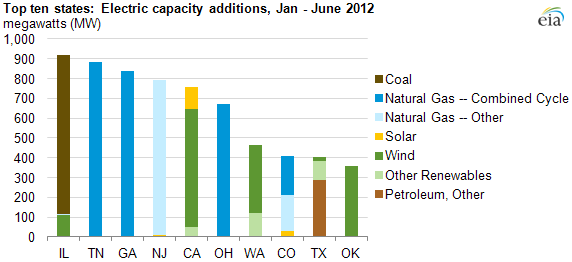(Updated August 29 with additional renewables data)
Since we reported earlier this week about the dominance of clean energy in additions to the US grid during the first half 2012, more encouraging data about clean energy adoption has come to our attention.
During the first six months of 2012 ended June 30, non-hydro renewable sources including biomass, geothermal, solar, wind provided 5.76% of net electrical generation, reports the latest issue of the "Electric Power Monthly, published by the US Energy Information Administration (EIA).
That was an increase of almost 11% over the first six months of 2011. In the last full year of the Bush Administration, non-hydro renewables represented 3.06% of net electrical generation, with an average monthly output of 10,500 gigawatt-hours.
By mid-2012, the average monthly electrical generation from non-hydro renewables reached 18,777 gigawatthours.
About one-third of the new capacity added to the grid in the first half of 2012 was from renewable energy, more than double then ew coal capacity that was added during that timeframe.
For more on the trends in new US electricity generation, read on for our original post.
—–
Electricity generated by either natural gas or renewable energy sources dominated the 8,098 megwatts (MW) of new US grid capacity added in the first half of 2012, reports the US Energy Information Administration (EIA).
10 states account for almost 80% of new capacity, or 6,500 MW: Illinois, Tennessee, Georgia, New Jersey, California, Ohio, Washington, Colorado, Texas, and Oklahoma.
Only one coal-fired generator came online, an 800 MW unit in llinois.
The chart below shows the grid additions in the 10 most active states.

Two-thirds of new power plants added to the US grid in the first half of 2012 are less than 25 MW in capacity, says EIA.
Why is that? The EIA gives two possible reasons. It could be because of the uptick we’ve been seeing in installations of small solar systems across the country, particularly in California.
Another explanation is that many of the systems installed during the first half are peaking generators, combustion turbines and internal combustion engines that operate when electric demand is at its highest, which tend to be on the small side.
Solar is demonstrating significant growth. Through June 2012, 1,308 MW of utility-scale solar has been added, tripling the solar capacity from 619 MW in early 2009. These estimates are on the low side – EIA says it didn’t include smaller distributed solar generators in this data set.
On the other hand, 3,092 MW of capacity was retired in the first half of 2012; over half was coal-fired, and 30% was petroleum-fired generators.
Chances are these numbers will look very different one year from now, if the US fails to extend the wind production tax credit and if Republican Mitt Romney moves into the White House.
For more detailed information on recent grid additions:
